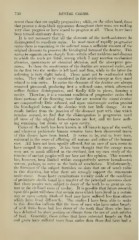Page 720 - My FlipBook
P. 720
730 DENTAL CARIES.
resent those that are rapidly progressive ; while, on the other hand, those
that present a deep-black appearance throughout their mass are making
very slow progress or have ceased to progress at all. These latter have
been termed stationary decays.
It is not necessary that all the elements of the tooth-substance be
disintegrated to constitute caries. In most cases of rapidly progressive
caries there is remaining in the softened mass a sufficient amount of the
original elements to preserve the histological forms of the dentine. This
serves to separate caries sharply from certain other accidents and diseases
to which the teeth are liable, among which I may mention mechanical
abiasion, spontaneous or chemical abrasion, and the absorptive pro-
cesses. In these the constituents of the dentine are removed entire, and
in the first two the surface is left hard and firm, while in the latter the
softening is very slight indeed. These must not be confomided with
caries. They will not be considered in this article except as they stand
related to true caries. In caries the elements of the dentine are always
removed piecemeal, producing first a softened mass, which afterward
suifers further disintegration, and finally falls to pieces, forming a
cavity. Therefore, it is a constant condition of progressive caries that
those portions of the decaying mass that are nearest the sound dentine
are comparatively little softened, and upon microscopic section present
the histological forms of the dentine M'ith but little change. As we
recede farther from the junction of the diseased part with that which
remains normal, we find that the disintegration is progressive until
all trace of the original form-elements are lost, and we have noth-
ing remaining but debris or an open cavity.
Caries of the teeth has been known in all historic ages of the world,
and wherever prehistoric human remains have been discovered traces
of this disease have been found. It seems to be, and to have been,
universal in the sense of affecting all nations and tribes of the human
race. All have not been equally affected, but no race of men seems to
have escaped its ravages. It has been thought that the savage races
were not so much afflicted as the civilized, but my own study of the
remains of ancient peoples will not bear out this opinion. This research
has, however, been limited within comparatively narrow bounds—too
narrow, perhaps, to serve as the basis of conclusions. Unfortunately,
the literature of the subject furnishes no data that are of much value
in this direction, l)ut what there are strongly support the statements
made above. Some hasty examinations recenth' made of the condition
of prehistoric skulls found in a number of the principal museums show
that those ])coples were subject to decay of the teeth to as great an ex-
tent as the civilized races of to-day. It is possible that future research
upon this point will show that certain races which have lived in a certain
way or u)>on certain kinds of food may have suffered less than others
which have lived differently. The studies I have been able to make
in this direction indicate that the races of men who have eaten largely
of acid fruits have had less decay of the teeth than* those who have
been debarr(>d by their position or climate from the use of such articles
of food. Generally, those tribes that have subsisted largely on flesh
and grain have suffered more from caries than those that have had a


